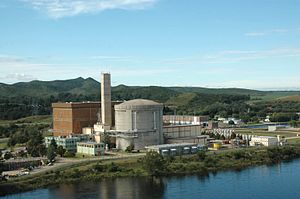The Embalse Nuclear Power Station (Spanish: Central Nuclear Embalse) is one of three operational nuclear power plants in Argentina. It is located on the southern shore of a reservoir on the Río Tercero, near the city of Embalse, Córdoba, 110 km south-southwest of Córdoba City.
| Embalse Nuclear Power Station | |
|---|---|
 | |
 | |
| Official name | Central Nuclear Embalse |
| Country | Argentina |
| Coordinates | 32°13′55″S 64°26′35″W / 32.232°S 64.443°W |
| Status | Operational |
| Construction began | 1974 |
| Commission date | 20 January 1984 |
| Operator | Nucleoeléctrica Argentina Sociedad Anónima |
| Nuclear power station | |
| Reactors | 1 |
| Reactor type | PHWR |
| Reactor supplier | CANDU |
| Thermal capacity | 2,015 MWt |
| Power generation | |
| Units operational | 1 × 683 MW (gross) |
| Nameplate capacity | 635 MW |
| Annual net output | 5,192 GW·h (2009) |
| External links | |
| Website | central nuclear embalse |
| Commons | Related media on Commons |
The plant is a CANDU Pressurised Heavy Water Reactor (PHWR). It employs natural uranium (that is, with 0.72% of 235U) and uses heavy water for cooling and neutron moderation. It has a thermal power of 2,109 MWth, and generates 648 MWe of electricity, with a net output of about 600 MWe, supplying nearly 4.5% of the production of the Argentine Interconnection System (2005).
Additionally, Embalse produces the cobalt-60 radioisotope, which is employed in medicine (cancer therapy) and industrial applications. Argentina is one of the largest producers and exporters of this isotope in the world,[1] along with Canada and Russia.
Embalse was started in 1974 and began operation in 1983 (first criticality 13 March 1983, declared commercial 20 January 1984). It was built by an Italian-Canadian consortium formed by AECL, acting as the "turn-key" supplier of the nuclear portion, and Italimpianti, the "turn-key" supplier of the conventional portion.[2]
On 31 December 2015, the plant was taken offline, having completed its first operating cycle of about 30 years.
On 1 September 2016, the plant received the last two of four steam generators, fundamental elements for the life extension of the plant. The plant was reconditioned to deliver power for another 30 years: the replacement of the four steam generators was one of the key steps. [3] The plant was restarted on 4 January 2019,[4] [5] with power upgraded to a gross capacity of 683 MW and 635 MW net.[6]
See also
editReferences
edit- ^ "Radioisotopes in Medicine | Nuclear Medicine - World Nuclear Association". www.world-nuclear.org.
- ^ Brooks, Gord L. (2 December 2002). "A Short History of the CANDU Nuclear Power System" (PDF). canteach.candu.org. Retrieved 4 September 2016.
p.18, In the case of the Cordoba (Argentina) project, AECL originally contracted to act as the "turn-key" supplier of the nuclear portion of the plant with its Italian partner, Italimpianti, acting as the "turn-key" supplier of the conventional portion.
- ^ "Llegaron los dos últimos generadores de vapor para la Central Nuclear Embalse". canteach.candu.org (in Spanish). Nucleoeléctrica Argentina S.A. 1 September 2016. Archived from the original on 3 September 2016. Retrieved 4 September 2016.
- ^ "BNamericas - The Embalse Nuclear Power Plant returns to s..." BNamericas.com.
- ^ "Embalse Nuclear Generating Station Life Extension". www.snclavalin.com. 13 April 2016. Archived from the original on 4 March 2017. Retrieved 24 March 2017.
- ^ "Argentina's Embalse Shuts Down For Major Refurbishment Programme". www.nucnet.org. 6 January 2016. Archived from the original on 25 March 2017. Retrieved 24 March 2017.
- (in Spanish) "la Central Nuclear de Embalse". CNEA. Archived from the original on 2 July 2010.
- (in English) "The Installations [ Part III] 3.3 Embalse Nuclear Power Plant". na-sa.com.ar: Nucleoeléctrica Argentina S.A. Archived from the original on 5 April 2006.
- Media related to Embalse Nuclear Power Plant at Wikimedia Commons